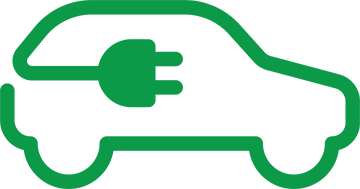When you drive your electric car in hot weather…
- Planning is key: make the most efficient use of your time and battery range.
- If you cannot charge your EV using excess solar, or cannot charge for free at work or home, then make sure you charge during off-peak times. That way you won’t spend as much money or time at public stations.
- Drive in “eco mode” to optimize battery efficiency. You may not drag as many people off at the lights, but you’ll reduce your energy consumption and conserve lots of energy to use for extending your range, for air conditioning, and optimize battery efficiency.
Let's define what we mean by EXTREME TEMPERATURE for EVs

- Extreme heat is when the temperature is above 95°F or 35°C.
- Extreme cold is considered to be temperatures below 20°F or -6°C.
Should you read this article if you never drive in extreme temperatures?
In this article you’ll learn simple ways to get better performance out of your EV in extreme heat. However, those same principles apply to driving at lower temperatures to different degrees (what a pun). And even though cold is a bigger issue than heat, it pays to understand what you can do to optimize your car’s efficiency when it’s very hot.
You could drive in extreme heat rarely or often. Either way, work out how big an issue extreme heat might be for you, and read on to learn some great tips about optimizing your EV’s performance, battery life and range.
Here’s what we’ll cover:
- Charge During the Cooler Hours
- Plan Your Route
- Plan Your Charging Stops (Even Charge for Free)
- Monitor Your Battery
- Remote Cool Your EV Interior
- Park in the Shade
- Drive Smart
- Use Eco Mode
- Bonus tip: Keep Your Tires Properly Inflated
1. Charge During the Cooler Hours
In regions of extreme heat (frequently above 95°F or 35°C) it can be better to charge your car somewhere cool… or at some time cool. For many that could be best when your grid-power charges are lowest… and where you’ll be charge off-peak rates. These times are generally very early morning, late at night or overnight.
Great reasons for off-peak charging.
- Power prices are highest if you charge at peak times. Off-peak is cheaper.
- Cheaper power is always a win. Remember, if you are able to charge at home using excess solar, charging will essentially be free.
- Off-peak rates are usually overnight when it’s cooler. Extreme heat can slow the rate of charge (take longer), and charging will be less efficient.
- Peak charging means there’s higher demand for power, which can mean charging speeds slow down (particularly at public chargers and can affect home-charging).
- If you are able to charge at home (with either level 1 or 2 (trickle or fast) charging) then AC charging will always be better for your battery—and generate less heat—than DC fast charging.
Fill up cheaply. Common to EVs and petrol cars
Just as you’d try to buy the cheapest gas when filling up the tank of an ICE car, you’ll probably try to top up your EV’s battery in the most cost-effective and efficient manner.
So, here’s a bonus tip. How to charge your battery cheaply or for free:
If you have the option to charge using off-peak electricity prices, then go ahead and do that. If you have a solar array on your roof at home or work, then see if you can use excess solar to charge your EV. That’s free energy from the sun! There are apps that work with your rooftop solar system and your EV charger wallbox to manage the power that comes into your home (both grid and solar) and determines where you use it (within your set parameters). If you charge using the cheapest power you can find, (whether free or not) you can minimize how much you spend at public charging stations.
And a word of advice: See if your employer will allow you to plug in at work. It might be a trickle charge, but you could top up for free. Some supermarkets, restaurants and other community facilities offer free charge points.
AC versus DC charging
Latest anecdotal information from countless EV owners shows that AC charging up to 100%, even daily, does not degrade the battery capacity (as long as the vehicle isn’t left to sit at 100% for a long period of time). What does degrade your battery, however, is frequent superfast DC charging above 80% capacity.
2. Plan Your Route
It’s worth it for drivers of all cars—whether electric or gas-powered—to use less fuel per mile (or km). At the moment it still takes longer to recharge an EV battery than to fill a gas tank. But the time difference will narrow as technology advances.

According to the Dept of Energy there are over 60,000 charging stations across the US, however, there are fewer of them than gas stations. This is why it’s worth spending a little time and attention planning longer routes, looking at proximity of charge stations, the routes you take (highway or city routes) and driving style (gentle, steady, sporty), and so on.
There’s a so-called sweet spot temperature for most EVs and that is about 70F or 21.5C. As efficiency would be plotted on a bell-shaped curve, temperatures in this vicinity would show no significant loss. So, there’s no need to be anxious. We’re really only concerned about EXTREMES in temperatures.
When the temperatures are very high, consistently above 95 degrees Fahrenheit, expect the state of charge to decrease more rapidly than at ‘regular operational temperatures’—between 20 to 95F (-6 to +35C). There are many places in the world that rarely fall outside of this ‘normal’ zone.
High temps generally affect an electric car’s efficiency less than extreme cold, but it’s worth knowing these important tips to optimize how your car operates.
Handy to know:
- EVs may use battery power faster than in mild temperatures. This is not just about the car itself, but also the use of air conditioning to keep the cabin comfortable.
- EVs may take longer to recharge when it’s very hot.
If you have a long commute and have less opportunity to charge your car at home or work, then try to combine errands in one trip.
3. Plan Your Charging Stops
When you plan your route, it’s good to plot potential charging stops. Unlike a petrol/diesel car, as an EV owner, you will probably not let your car’s state of charge drop to very low levels before recharging. Most owners of electric cars get in the habit of shorter charge stops to part-fill or top-up the battery (and have drink and a short break), rather than aiming for a 100% charge each stop. It’s a different way of thinking.
Your EV will probably have tools onboard (visible on the screen) which will assist you to map the most suitable route. Often displayed are the closest charging stations. And, if you touch the screen, the onboard GPS will navigate you there. Other online tools and apps on your smartphone may provide real-time data. With little effort you will find the location of EV charging stations, their availability, user feedback and even info that rates the charger on reliability. Use them to map out the most convenient charging stops along your route.
Free charging:
You’ll be pleasantly surprised how many commercial establishments are willing to provide free power to encourage you to visit their facilities. You will often find charging points at many community areas such as grocery stores, and restaurant parking lots. Charging a car can be an excellent way to combine errands; charging and shopping, or charging and dining.
4. Monitor Your Battery
Just as in most modern appliances (from watches and phones, and desktops), your battery has a Battery Management System or BMS. Most vehicles can give you realtime stats on the state of charge (SOC). SOC is expressed as a percentage and you’ll generally see that figure on your screen. You may get extra info regarding the battery’s temperature.
While your battery is unlikely to get too hot when the car is being driven (most modern EVs have cooling systems and even air vents to assist when in motion), constant parking of the vehicle in very hot conditions and exposed to full sun is not recommended as it can impact battery life.
5. Remote Cool Your EV Interior

Some cars allow you to remotely cool your car. But why would you want to do this? In extreme heat (above 95°F or 35°C) and if your car is already plugged in, if you activate and pre-cool the cabin, you will do two things:
- You’ll create a comfortably cool environment from the moment you get in the car. And,
- You’ll lessen the load on the battery to run the air conditioning system. As the cabin will already be cool, your car will be more efficient to drive in the hot weather.
Remote cooling is a type of ‘preconditioning’ but that term more accurately describes preparing the battery to accept charge under optimal conditions, when you are experiencing extremely cold conditions. You don’t need to precondition in hot temperatures.
Preconditioning is a useful strategy when you want to charge your car in extreme cold… under 20 degrees F (or -6°C). Preconditioning raises the temperature of your battery to facilitate efficient charging and especially useful when you use superfast (DC) chargers.
6. Park in the Shade
If you’re experiencing extremely hot weather (about 100°F), and if you plan to leave your car unattended for an extended time, then cooling it with a blast of air-conditioning to lower the cabin temp will take more energy and impact range. But hey, it does this in a fossil-fuelled car too! So, think about parking in cooler areas (in the shade or undercover). Alternatively, use sunshades on the windows.
7. Drive Smart
Remember that in hot weather you can conserve battery and range with steady driving. Steep rates of acceleration will diminish SOC quickly, but sharper deceleration can help regenerate energy and feed it back into the battery! So, when you drive smoothly WITH one-pedal driving, (or a high regeneration setting) it can assist you on very hot days to conserve power. Heavy loads can lessen your range so super-hot days might not be the best day to choose to move house.
8. Use Eco Mode
Your car has an inbuilt way to cut back on energy use. It’s called Eco-Mode and it’s your car’s intelligent way to optimize battery use, automatically. But it does require driver input. Further efficiency will come from using regen braking and using smart driving skills (see above).
9. Bonus Tip: Keep Your Tires Properly Inflated
Here’s another tip that applies to all vehicles, all the time. Get your tire pressure right! If your tires are underinflated, your range will be smaller because rolling resistance increases. And handling and stability will suffer if your tires are not pumped up enough.
Many new EVs can display your tire pressures on your console. Remember too, that tire pressures vary a lot during hot weather. The hot air expands the tires, so it's important to know the psi that’s optimal for your car. It may be advisable to set the pressure at the low end of the range in summer and the higher end of the range for winter. The commonly accepted range is 30 – 35 psi. Monitor your pressures. Boost performance. Increase your range.

